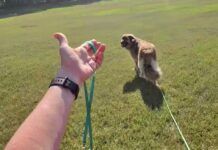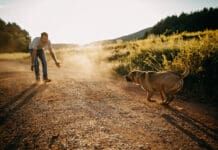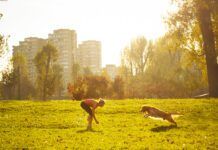At a recent outdoor social for our clients and their off-leash dogs, my own dog, Willow, joined in the fun. In addition to helping her continue to enjoy the company of a variety of other dogs, I also use times like this to practice recall. Over the course of 45 minutes, I called her to me six or eight times and each recall was met with this success: Willow leaving the action and returning to me immediately, enthusiastically and with rocket-like speed. One client asked, “How in the world do you do that?” My simple answer was, “You train it.”
I get immense enjoyment doing a variety of things with Willow – hiking, swimming, stand-up paddleboarding – all of which are more enjoyable because I know she has a rocket recall. I define that as, “That glorious moment when anytime and anywhere you say ‘Come!’ and your dog immediately and enthusiastically turns on a dime and bounds rapidly to you.” Sound impossible? It’s not. It can be done.
In our two-day Rocket Recall workshops, I tell participants that an indoor, off-leash recall is like a high school diploma – pretty easy to get – but an off-leash, outdoor recall is like a PhD. Admittedly, that’s an exaggeration, but it gets the point across. A reliable rocket recall just doesn’t miraculously happen.
Having worked with hundreds of dogs and clients over the years, we’ve created a systematic way of training recall that includes The 12 Rules of Rocket Recall, a list of very important things to remember.

Ways to Fail at Teaching Your Dog a Recall
Before I discuss the training steps, though, let’s consider a few common training mistakes:
- Not training. Recall is a learned behavior, just like anything else you teach your dog. It’s not hard to teach and it’s not hard to train, but you do have to do the work. Unfortunately, dogs don’t come with an English software package installed, so it’s up to us to teach them the behavior, then add the cue (see “Clean Up Your Cues!” WDJ August 2015) and then practice the recall so that the dog truly learns the behavior.
- If trained, not practicing. Practice should take place through all four stages of learning: acquisition, fluency, generalization, and maintenance. First, the dog has to begin to acquire the skill of returning to you. Then you continue to practice so that the behavior is fluent and is occurring with regularity. Next, generalize the behavior of coming to you in a variety of places and settings, always beginning in a low-distraction environment, and as your dog makes progress, moving to a slightly more distracting environment.
Do all of this before ever practicing in a highly distracting environment (such as off-leash play with other dogs). Eventually you reach the maintenance phase of learning, where you continue to practice recall so that the behavior stays solid.
Here’s an example: I used to be a very good mandolin player. I first learned to play a few tunes (acquisition). I got pretty good because I continued to practice daily and could play a lot of tunes well at home (fluency). I then generalized the behavior of playing the mandolin to a variety of places (at home with friends, at a music jam in public, playing on stage, etc.) and I maintained that level of proficiency for a while. But life got busy and I stopped practicing – no maintenance! Result? My mandolin playing isn’t so great anymore.
- Using the cue and then ignoring the dog. Here’s a common scenario: People train their dog to come to them when they say “Come” – but almost as soon as that is accomplished, they begin using the word very casually and taking the (formerly much sought-after) behavior for granted, and failing to even acknowledge, much less reward it.
As an example, say you use the word “Come” to call your dog when she’s outside enjoying herself; she returns to you the first time you call because you’re nice to her and you feed her; there’s a bit of reinforcement history between the two of you. But then you bring her inside the house, you pick up your car keys, and you go to work.
From your dog’s perspective, you’ve just taken the “good stuff” away (the outdoors with all those awesome smells!) and ignored her (by locking her inside and going to work). In dog training, taking the good stuff away constitutes punishment, and punishment makes the behavior of coming to you less likely.
- Punishing your dog for not coming. If there’s one sure way to insure your dog never comes back to you, it’s yelling or screaming at (or heaven forbid, hitting) your dog when she doesn’t come back to you. If you do this, it cements in your dog’s brain that you’re unpredictable and the behavior you cherish and want so much is very likely to not happen again.
Things You Should Do for a Rocket Recall
Enough of what you don’t want to do! Here’s how I taught my own girl, Willow, and how you can to train an effective “rocket recall” for your dog:
- Understand how dogs learn. Dogs learn by association and by consequence. Learning by association means that dogs are always making decisions about what’s safe and what’s not in their world. Making the recall training process fun helps your dog develop a positive emotional response to the exercise.
Dogs also constantly make decisions based on consequence (i.e., “Is this good for me or is this bad for me?”). Reinforcing your dog each and every time she returns to you will increase the likelihood she’ll return to you again. The consequence of returning equals something awesome (with a high-value reinforcer such as an especially yummy treat or a game of tug).
- Understand the value and timing of reinforcers. Reinforcement for the behavior of returning to you should be immediate and must be of “high value” to your dog – something your dog loves. Don’t buy one box of treats and plan to use them exclusively as the reward; try a number of treats so you can determine which your dog likes the most. I’ve met dogs who would spit out a hot dog in a nanosecond and preferred carrots. That said, food is a primary reinforcer for dogs and a good choice, though for some dogs a game of tug or the opportunity to chase a toy is more reinforcing.
Timing of the reinforcement is also very important; it must be immediate. If you call your dog from the back porch and she comes running toward you, but she doesn’t get a reward for this until you go back inside the house and enter the kitchen, open a treat jar, and wait for her to sit before you pop it into her mouth – in reality you’re reinforcing her for sitting in the kitchen.
- Appropriate pairing of reinforcers and distractions. Think of reinforcement as your dog’s paycheck. I like to pay my dog well for succeeding with challenging work. Because each dog values a specific reinforcer differently, experiment to find out which foods or other reinforcers your dog likes and which ones she really likes. Be creative! Build a written reinforcement hierarchy. Identify 10 to 20 reinforcers (food, toys, and other things your dog loves) and rank those as low-, medium-, or high-value reinforcers. Then identify 10 to 20 distractions (another dog, a squirrel, a fire truck roaring by with siren blaring) and rank those as being worthy of low-, medium-, or high-value rewards if ignored by your dog. This helps you understand how your dog views her world; what’s important to her?
Your next step is to look at each list and pair the distractions and reinforcers wisely. Use high-value reinforcers for high-value distractions. If paired inappropriately, your dog’s focus and your training suffer, but if paired suitably, everyone succeeds. For example, I use something Willow will do backflips over (steak) if I plan to do training in a new, outdoor environment where there may be squirrels running about. Choose wisely!
Play focus & attention games. (Note: I call training exercises “games,” because games are fun, and if you and your dog are both having fun, then training is bound to be successful.) There are two main focus and attention games I play with my dogs: “Capturing Attention” and “The Name Game.”
Capturing Attention. The goal of this game is to teach your dog to “check in” with you. Stand with your dog on leash and merely observe your dog without talking to her. Your goal is to set her up for success, so please practice initially in a no-distraction environment.
Say nothing at all to your dog; merely watch her. The instant your dog orients toward you or looks at you, mark the behavior with a verbal Yes! or the click of a clicker, reinforce with a yummy treat, verbally praise your dog, and then take your attention off your dog for a moment. Removing your eye contact gives your dog permission to return to visually explore the environment.
Repeat this exercise until you’ve achieved success in the no-distraction environment; then slowly work up to success in gradually more distracting environments. You can begin with a six-foot leash and gradually work up to using a 20-foot (or longer) long line.
Watch how the “Capturing Attention” game is played.
The Name Game. This game teaches your dog to immediately look toward you when her is spoken. Your dog’s name should mean, “Look immediately at me and wait for further instruction!” Your dog’s name does not mean: Get out of the trash; stop chasing the cat; or drop my shoe! You want your dog to always feel awesome when you say her name.
Again, begin on leash and in a distraction-free environment. When your dog is slightly distracted, say her name (one time) in a happy tone of voice; the instant she turns her head toward you, mark the behavior with a Yes! or the click of a clicker, and reinforce with a yummy treat and verbal praise. Then withdraw your attention for a moment, giving her a chance to look away.
If she doesn’t look at you immediately when you say her name, resist the urge to repeat her name. Instead, make a kissy or squeaky noise that will likely get her attention. Then you can mark her look toward you with a Yes! or a click and reinforce her with a treat or other reinforcer.

Pick a cue
Once you’re successful with Capturing Attention and The Name Game, it’s time to pick a cue. If your dog hasn’t been reliably responding to your current cue at least 75 percent of the time, pick a new cue. It’s easier to condition a new cue than it is to change the emotional response to an old one. Common cues are Come! and Here!, though I highly encourage you to pick a fun cue, such as Shazam!, Cookie!, Batman!, Lottery!, or Happy Hour!
Turn on the cue with an exercise that is designed to help your dog develop a positive feeling about the word you’ve chosen for your recall cue. You’ll give the cue value by pairing the word with some high-value food (remember, your dog gets to choose what’s of high value to her). Count out 10 pea-sized pieces of food. Say your recall cue (such as “Shazam!”) and then immediately pop a treat into your dog’s mouth. Repeat 10 times. Practice this exercise two times a day for a week. Very quickly, your dog will associate the cue (Shazam!) with the experience of yummy food and you’ll have created a very positive association with the cue.
Then it’s time to play the “Chase Me” game, which takes advantage of your dog’s natural desire to chase. With your dog on leash and your body facing away from her, say her name; when she looks at you (from all that fun “Name Game” work), turn and trot away from her as you say your recall cue, “Shazam!” in a very happy tone of voice. As your dog starts to follow you, continue to encourage her as she moves toward you, then click or say Yes! while she’s in movement toward you.
When she reaches you, put your hand on her collar and feed her a treat. After you deliver the treat, lavishly reward her with tiny bits of reinforcers (yummy food), one after another (rather than in a single handful) for a minimum of 15 to 30 seconds, combined with lots of verbal praise. Before long, as you say your recall cue, she’ll be enthusiastically bounding with you as you run. You want to be animated and enthusiastic in your approach to this fun exercise. Channel a Looney Tunes character!
As your dog gains success on a short leash, you can transition to a longer line (20 to 50 feet) while continuing to play the “Chase Me” game. When you’re successful with a long line, find a safe, fenced area to practice off-leash recalls. Remember that when you move to practicing off leash, you will need to decrease the distance she travels to you so that your dog can be successful in that new, more challenging environment.
See video of “turning on the cue” and the “chase me” game.
Practice, practice, practice
We learn by repetition and so do dogs. Training doesn’t have to be laborious. In fact, it shouldn’t be. Practicing recall with your dog in short 3- to 5-minute sessions is much better than a long session. Keep it interesting for your dog and remember to set her up for success. You want her to get it right the first time. Getting it right means she earns reinforcement, and reinforcement makes a behavior happen again. Don’t forget those four stages of learning: Your dog first has to acquire the skill and generalize it to a variety of situations and locations before it becomes fluent. Then you’ll need to continue to train the skill periodically to maintain the behavior so it’s always strong.
Recall & Release game
This game will strengthen your dog’s recall. When your dog successfully returns to you, reinforce her and then immediately release her to go play or return to whatever it is she was doing before you called. This game is beneficial in helping your dog learn that returning to you when you call doesn’t always end the fun.
Putting It All Together
Here’s an example of how I set up Willow for success in the early days of our training together: During multi-dog, off-leash play groups, I waited until Willow had been running around for 5 or 10 minutes and was beginning to tire from playing with the other dogs. As she began to disengage from a play group, I’d position myself a few feet away from her (my body facing away from her), and call her name.
As she immediately looked at me, I’d say her recall cue (in a very happy tone of voice), and then run away from her. As she began to follow me, I’d mark that behavior with a verbal Yes!, praise her as if she were the best dog in the whole wide world (she is, of course), and reinforce her with her favorite treat.
Practicing this way, over time, now allows me to call her away from other dogs when she’s still engaged in play. Pretty amazing!
There’s an incredible peace of mind that comes with knowing your dog will reliably return to you anywhere and anytime when you call. It will help you enjoy more fun, off-leash activities and it can also save your dog’s life.
So get up, get going, start training, and you’ll be on your way to getting that coveted rocket recall from your dog, every time.
The 12 Rules of Rocket Recall
1. Train it! Practice it!
2. Use the reinforcers that have the highest value for your dog for recall practice.
3. Reward ALL check-ins during other times of the day
(a check-in is any time your dog chooses to visit you of his
own accord).
4. Don’t call a dog for anything he doesn’t or won’t like (such as trimming nails).
5. Don’t call your dog if you don’t think he will come (i.e., if your dog is riveted by a twitching squirrel).
6. If you make a mistake on #5, “save” the recall by going to get your dog, encouraging her to move with you, and then rewarding her.
7. Don’t repeat the cue! Say it only once, then make yourself as interesting as possible, “squeaking” in a high-pitched voice, clapping, jogging away, etc.
8. Never, ever, punish your dog if she doesn’t come to you.
9. HUGE payoff – always give lots of treats or something novel and special when your dog returns to you.
10. Maintain it after you train it! Practice at least three times a week for life.
11. Play Hide & Seek.
12. Play the Recall & Release Game.





